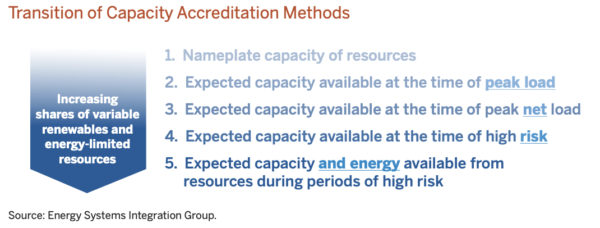Looking toward the next phase of the energy transition, when renewables, storage and load flexibility will increasingly be used to ensure grid reliability, a report from Energy Systems Integration Group (ESIG) considers how individual resources should be credited for their contribution to resource adequacy. ESIG is a nonprofit educational organization whose mission is to chart the future of grid transformation and energy systems integration.
The report uses the term “capacity accreditation” to describe this process, and says that other common terms are capacity credit, capacity value, capacity contribution, effective capacity, or firm capacity. The resource adequacy metric aims to ensure that a system has enough resources to serve all customers at all times.
Capacity accreditation “is often applied only to wind, solar, and storage,” says the report, even though “large portions” of thermal generating capacity can go offline simultaneously due to extreme weather and fuel supply disruptions, citing Winter Storm Uri and Winter Storm Elliott.
These omissions “at best over-compensate gas and coal resources for their reliability contributions; at worst, they pose an unrecognized reliability challenge for the grid,” says a fact sheet accompanying the report. To address this problem, the report’s first recommended “pillar” of resource accreditation is that it be non-discriminatory, and its first “key consideration” is that accreditation should be expanded and applied to all resource types.

The second key consideration is that “there is a need to link simulated accreditation” based on power system modeling “with actual operations.” An accompanying fact sheet puts it more bluntly, saying “pay resources for what they do, not for what they are.”
As the grid transitions to increasing shares of variable renewables and energy-limited resources, such as 4-hour batteries, the report proposes that the method for crediting capacity for any resource should be robust, and ultimately should credit the expected capacity and energy available from resources during periods of high risk.

The report describes two options for simplifying the capacity accreditation process: the marginal reliability improvement process, and a loss-of-load probability (LOLP) capacity factor approach.
The LOLP capacity factor approach “only requires a single resource adequacy simulation” to set the unserved energy hours and “does not require iterative modeling for each resource type,” the report says. As a result, “it can easily be applied to all resource classes and even individual resources in a consistent, non-discriminatory manner.”
The report, titled “Ensuring efficient reliability: New design principles for capacity accreditation,” was produced by ESIG’s task force on redefining resource adequacy, and prepared by Derek Stenclik, the task force chair and a founding partner of Telos Energy. The report concludes with six recommendations.
This content is protected by copyright and may not be reused. If you want to cooperate with us and would like to reuse some of our content, please contact: editors@pv-magazine.com.








Thank you for all the work your PV Magazine does for getting information about – change – out to us, people who want, and are buying into, actually Green energy. We are going with Microgrid into the future, but we will be in the way of the monopoly corporations’ hard work to maintain their own protected, advantaged Business model. Of local concern in particular: previous – last century – industry-concocted – measures – of the “value” of remaining wild desert open spaces and large functioning ecosystems.
No part of the Mojave Desert was or is “free”, “unlimited” “wasteland”.
The 5 Pillars, and other new views and counts of energy production value – measuring, help. (Can no longer crash irreplaceable natural resources to meet and grow preferred profit expectation reports, for commercial industry – and call that Green – for points). We recognize 1620-1872-1976 FLPMA culture and infrastructure for energy production, is not going to ever be competetively, actually, Green, or practical, or even desirable for consumers. That was never a top consideration for speculative investors. We here, do like solar, just not done “The only way! it can work! – right!”. — For utility corporations.